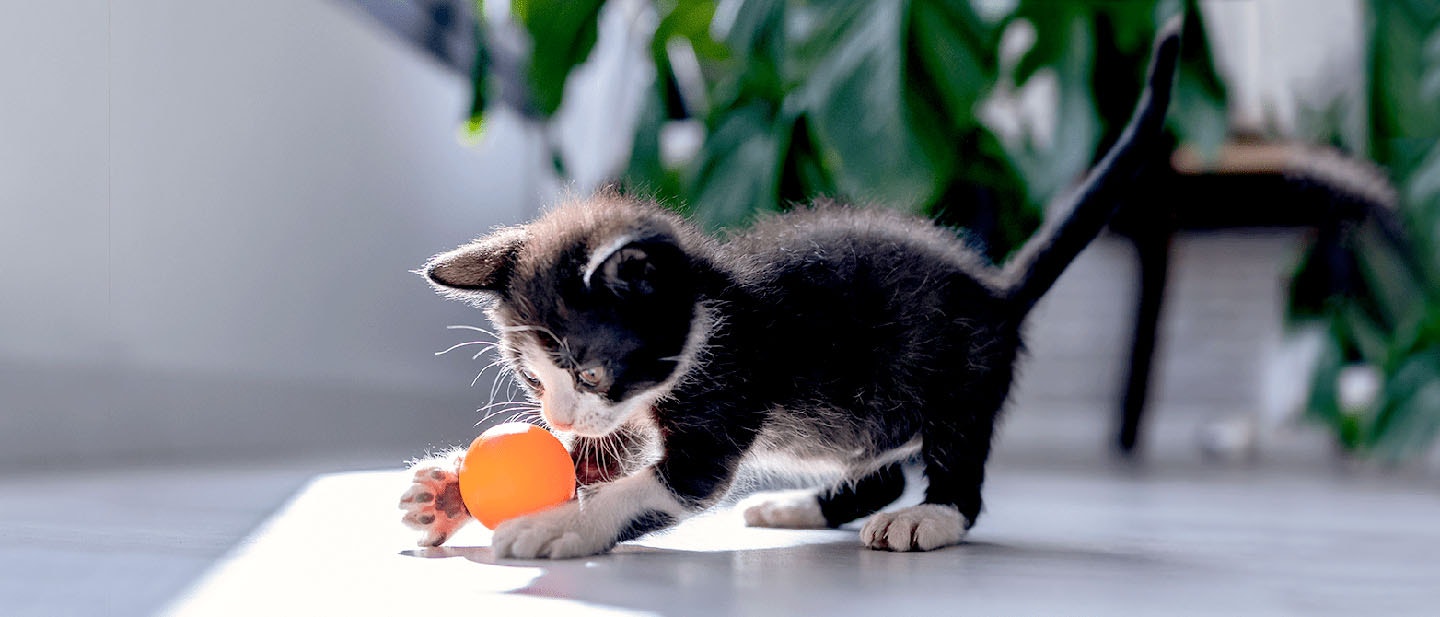
How to Play with Your Kitten: 5 Fun Games & Tips
Kittens playing is not just a delightful experience, it is an essential part of a young cat's development. This period is where your fur baby learns vital social skills, coordination, and the art of communication through chasing and pouncing. So, let us explore the amusing world of kittens playing and understand the impact of playful moments on their emotional and physical health. From the benefits of playing with your kitten to how to play with kittens without toys, we will uncover all the essential aspects of kitten playtime.
Why is it important for kittens to play?
Engaging in playtime is fundamental for kittens, especially because it acts as an educational tool that shape their physical and social development. When a kitten is playing, it explores the movement of its body, enhancing its agility, strength, and coordination. This period of playfulness also acts as a practice ground for vital survival skills that come in handy in their day-to-day lives.
When you play with kittens, you teach them to establish boundaries, learn feline communication cues, and develop confidence in their environment. It is a process that ensures kittens grow into well-adjusted, healthy adult cats, capable of navigating the complexities of their world with ease.
Let us help you navigate into the world of kitties playing.
Benefits of playing with your kitten
Playing with your kitten fosters a deep bond between the two of you, laying the foundation for a trusting and affectionate relationship. It is an investment in their emotional well-being, providing them with a sense of security and belonging. Along with it, playtime also serves as an essential outlet for a kitten’s boundless energy, which further prevents behavioural issues linked to boredom and excess energy. It stimulates their mind, encourages positive behaviour, and keeps them physically fit. Regular kitten playing sessions can also help in identifying any unusual personality traits or health issues early on. Ultimately, engaging in play enriches your kitten’s life, ensuring it to be happy, balanced, and healthy.
Types of toys for kittens
Playing with kittens can be a perfect bonding activity for both of you. Add some fun toys to the equation and take your playtime to the next level:
Fishing poles and teasers
Entice with movements that mimic small prey to stimulate your kittens’ hunting instincts.
Mice toys
Encourage your kittens to chase, bat, and pounce with plush or plastic mice toys that simulate the experience of catching prey.
Interactive toys
Engage your kittens with puzzles or moving elements for mental stimulation and physical activity.
Scratchers
Provide scratching posts or mats to ensure your kittens’ claw health and prevent furniture scratching.
Tunnels
Offer exploration and hiding spaces to promote physical exercise and satisfy the instinct to investigate.
Climbing toys
Encourage vertical exploration and exercise with climbing toys to develop their strength and agility.
Catnip toys
Stimulate senses and promote playfulness to make this enriching bonding activity more enticing and enjoyable for your kittens.
Wand Toys
Engage in interactive play with your fur babies to strengthen your bond and provide them with exercise.
Balls
Spark the urge of chasing and batting with this simple yet effective toy which also offers endless entertainment and physical activity.
How to play with your kitten?
If you are wondering how to play with your kitten in a way that is a valuable addition to their overall development, you can begin with the following:
Play with appropriate toys
Use toys that mimic prey, such as wand toys or mice, to engage your kitten's hunting instinct. Avoid using your hands or fingers as toys to prevent teaching them that biting or scratching people is acceptable.
Engage in versatile activities
Keep playtime interesting by rotating through different types of toys. This helps stimulate your kittens’ mind and keeps them interested in playtime.
Incorporate training into play
Use playtime as an opportunity to teach your kittens commands or tricks. Reward them to reinforce positive behavior.
Interactive play sessions
Spend time each day interacting directly with your kittens through play. This strengthens your bond and provides them with the social interaction they need.
Monitor playtime
Always supervise playtime to ensure that your kittens are safe and not ingesting parts of toys. Do not forget to replace damaged toys with new ones to prevent choking hazards.
How much should kittens play?
It is important to balance your kitten’s playing time with other activities that they need to grow and thrive. You can use the below points as a guideline to understand how long should you play with your kitten.
Frequent short sessions
Kittens have a lot of energy but a short attention span. Aim for multiple short play sessions throughout the day, ranging from 5-15 minutes each.
Total daily playtime
On average, kittens benefit from about 2-3 hours of playtime per day, split across various sessions. This can vary based on your kittens’ age, breed, and energy level.
Adjust playtime as per age and energy
Younger kittens may require more frequent yet short play sessions, while older kittens might engage in longer periods of play. Watch for signs of tiredness or overstimulation and adjust playtime accordingly.
Incorporate rest
Ensure that there is plenty of time for rest and relaxation between play sessions. Kittens grow and develop while asleep, making rest as important as play.
These factors can be crucial in determining how long kittens should play, and how often you should play with your kitten. By keeping the above mentioned points in mind, you can ensure that playtime is an enriching experience for your kitten, without pushing it too far. Remember, it is always important that the little feline gets its rest, so it is prepared for the next session of fun.
How to turn playtime into a form of exercise?
To make playtime an effective form of exercise for kittens, you must stimulate their natural instincts. Aside from how long should you play with your kitten, understanding how often you should play with your kitten is essential for turning playtime into exercise. Incorporate toys and games that encourage running, jumping, and climbing, such as laser pointers for chasing and climbing structures for exploration. This not only helps burn energy but also aids in muscle development and coordination. You can also use puzzle feeders during playtime to keep them physically and mentally active while trying to access food.
Nutrition plays a pivotal role in supporting kittens’ energy levels and overall health, especially when playtime is used as a form of exercise. Before learning how to play with your kitten in an efficient manner, it is crucial to find the perfectly balanced diet, rich in proteins and essential nutrients, so your little feline friend can be at its healthiest for the playtime. Hence, at WHISKAS®, we offer a range of high-quality kitten food, which is specially formulated in collaboration with veterinarians to meet the nutritional needs of growing kittens. Remember, well-fed-kitties playing are energetic and happy, ready to engage in the physical activities that contribute to their well-being.
Why are some kittens more active than others?
The activity levels in kittens can vary widely, influenced by a range of factors that make some kitties more active than others. Genetics play a significant role, with certain breeds like Abyssinian cats, Bengal cats, Burmese cats, and Japanese Bobtail cats exhibiting higher energy levels and a greater enthusiasm for playtime. Additionally, individual personality traits contribute to kittens’ activity level. Some may be naturally curious and active, seeking out adventure and exploration, while others may be more laid-back and content with less physical activity.


